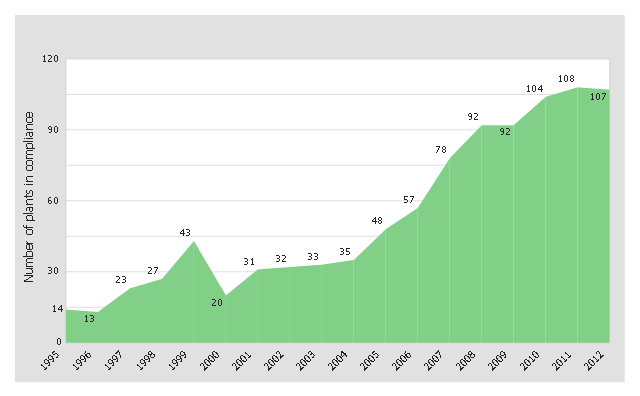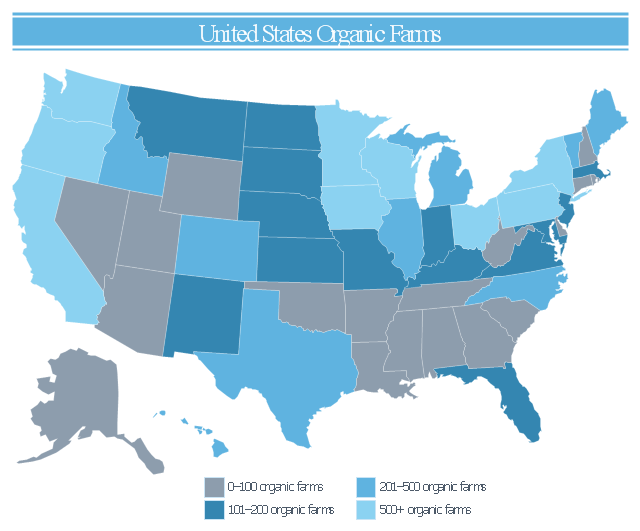This area chart sample was redesigned from the picture "Outstanding trends of wastewater treatment plants" from the Washington State Department of Ecology website.
[ecy.wa.gov/ programs/ wq/ wastewater/ op_ cert/ kudos.html]
"Sewage treatment is the process of removing contaminants from wastewater and household sewage, both runoff (effluents), domestic, commercial and institutional. It includes physical, chemical, and biological processes to remove physical, chemical and biological contaminants. Its objective is to produce an environmentally safe fluid waste stream (or treated effluent) and a solid waste (or treated sludge) suitable for disposal or reuse (usually as farm fertilizer). Using advanced technology it is now possible to re-use sewage effluent for drinking water, although Singapore is the only country to implement such technology on a production scale in its production of NEWater." [Sewage treatment. Wikipedia]
The area graph example "Outstanding trends of wastewater treatment plants" was created using the ConceptDraw PRO diagramming and vector drawing software extended with the Area Charts solution from the Graphs and Charts area of ConceptDraw Solution Park.
[ecy.wa.gov/ programs/ wq/ wastewater/ op_ cert/ kudos.html]
"Sewage treatment is the process of removing contaminants from wastewater and household sewage, both runoff (effluents), domestic, commercial and institutional. It includes physical, chemical, and biological processes to remove physical, chemical and biological contaminants. Its objective is to produce an environmentally safe fluid waste stream (or treated effluent) and a solid waste (or treated sludge) suitable for disposal or reuse (usually as farm fertilizer). Using advanced technology it is now possible to re-use sewage effluent for drinking water, although Singapore is the only country to implement such technology on a production scale in its production of NEWater." [Sewage treatment. Wikipedia]
The area graph example "Outstanding trends of wastewater treatment plants" was created using the ConceptDraw PRO diagramming and vector drawing software extended with the Area Charts solution from the Graphs and Charts area of ConceptDraw Solution Park.
This infogram sample was redesigned from the Wikimedia Commons file: 2007 United States Organic Farms.svg.
"A map of the United States showing the number of organic farms per state in 2007." [commons.wikimedia.org/ wiki/ File:2007_ United_ States_ Organic_ Farms.svg]
This file is licensed under the Creative Commons Attribution-Share Alike 3.0 Unported license. [creativecommons.org/ licenses/ by-sa/ 3.0/ deed.en]
"Organic farming is a form of agriculture that relies on techniques such as crop rotation, green manure, compost, and biological pest control. Depending on whose definition is used, organic farming uses fertilizers and pesticides (which include herbicides, insecticides and fungicides) if they are considered natural (such as bone meal from animals or pyrethrin from flowers), but it excludes or strictly limits the use of various methods (including synthetic petrochemical fertilizers and pesticides; plant growth regulators such as hormones; antibiotic use in livestock; genetically modified organisms; human sewage sludge; and nanomaterials.) for reasons including sustainability, openness, independence, health, and safety." [Organic farming. Wikipedia]
The thematic map example "United States organic farms" was created using the ConceptDraw PRO diagramming and vector drawing software extended with the Management Infographics solition from the area "Business Infographics" in ConceptDraw Solution Park.
"A map of the United States showing the number of organic farms per state in 2007." [commons.wikimedia.org/ wiki/ File:2007_ United_ States_ Organic_ Farms.svg]
This file is licensed under the Creative Commons Attribution-Share Alike 3.0 Unported license. [creativecommons.org/ licenses/ by-sa/ 3.0/ deed.en]
"Organic farming is a form of agriculture that relies on techniques such as crop rotation, green manure, compost, and biological pest control. Depending on whose definition is used, organic farming uses fertilizers and pesticides (which include herbicides, insecticides and fungicides) if they are considered natural (such as bone meal from animals or pyrethrin from flowers), but it excludes or strictly limits the use of various methods (including synthetic petrochemical fertilizers and pesticides; plant growth regulators such as hormones; antibiotic use in livestock; genetically modified organisms; human sewage sludge; and nanomaterials.) for reasons including sustainability, openness, independence, health, and safety." [Organic farming. Wikipedia]
The thematic map example "United States organic farms" was created using the ConceptDraw PRO diagramming and vector drawing software extended with the Management Infographics solition from the area "Business Infographics" in ConceptDraw Solution Park.
- Benefit Corporation legislation - Thematic map | United States ...
- Tropical garden | Tropical garden | Zodiac constellations - Vector ...
- Tropical garden | Domestic garden | Garden layout | Flowee Tree ...
- Outstanding trends of wastewater treatment plants | Wastewater ...
- How to Draw a Landscape Design Plan | Residential quarter site ...
- Outstanding trends of wastewater treatment plants | Building ...
- Outstanding trends of wastewater treatment plants | House plumbing ...
- How to Draw a Landscape Design Plan | How To use Landscape ...
- United States organic farms | Pest
- United States organic farms | Map Of Pest Control Business Over ...
- Map Of The Us Showing States
- Design elements - Garden paths and walkways | How To use ...
- Manufacturing 8 Ms fishbone diagram - Template | How Do ...
- Geo Map - United States of America Map | Benefit Corporation ...
- Design elements - Ponds and Fountains | Education pictograms ...

